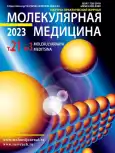Изменения сосудистой структуры сетчатки и биохимических маркеров крови у белых крыс на модели кратковременной артериальной гипертензии
- Авторы: Алиева Г.В.1,2, Гараева Г.Г.1,2
-
Учреждения:
- Медицинский Центр «Бадам» Азербайджана
- Центральный Военный Госпиталь Министерства Обороны Азербайджана
- Выпуск: Том 21, № 3 (2023)
- Страницы: 29-38
- Раздел: Оригинальные исследования
- URL: https://journals.eco-vector.com/1728-2918/article/view/568242
- DOI: https://doi.org/10.29296/24999490-2023-03-04
- ID: 568242
Цитировать
Аннотация
Введение. В лечении артериальной гипертензии (АГ) достигнуты большие успехи. Однако несмотря на то, что новые технологии проложили дорогу практической медицине, число смертей и инвалидности от болезней сердечно-сосудистой системы продолжает увеличиваться. Среди этих патологий важное место занимает АГ.
Цель исследования. Определить корреляционную связь между изменениями содержания креатинина, мочевины, остаточного азота (ОА), активности ферментов креатинфосфокиназы (КФК) и лактатдегидрогеназы (ЛДГ) в крови в начальной стадии АГ и сосудистой структуры сетчатки.
Материал и методы. Исследования проведены на 15 кроликах породы шиншилла массой тела 3–4 кг, которые были разделены на 3 группы по 5 голов в каждой. Концентрацию креатинина, мочевины, ОА, активности КФК и ЛДГ в крови определяли с помощью наборов реагентов производства компании Human на полуавтоматическом приборе BioScreen-2000 производства США.
Результаты и обсуждение. Установлено, что у интактных кроликов (1-я группа) систолическое АД колебалось в пределах 100–130 мм рт. ст., а диастолическое – 70–84 мм рт. ст. Креатинин крови колебался от 70 до 84 мг/дл, а концентрация мочевины — от 10 до 42 мг/дл. Активность ЛДГ варьировала в широких пределах от 230 до 430 ед/л. Общая площадь артерий среднего диаметра составляет 4800–5600 мкм3, а размер их проницаемости – 150–290 км. В результате введения в вену подопытным животным, включенным во 2-ю группу в течение 3 сут эргометрина малеата (ЭМ) уровень АД изменялся умеренно по сравнению с 1-й группой. На фоне относительно умеренного повышения АД, количество креатинина в крови увеличилось на 5% по сравнению с 1-й группой. Концентрация мочевины увеличилась на 12%. Активность КФК в крови значительно (4%) увеличилась, в отличие от ОА. Активность фермента ЛДГ значительно увеличилась (10%) (р=0,05). В 3-й группе наблюдалось повышение систолического и диастолического АД. Количество ОА значительно увеличилось. Значительные изменения наблюдались в концентрациях маркеров, характеризующих функциональное состояние печени (КФК, ЛДГ).
Заключение. Таким образом, можно сделать вывод, что кратковременное введение в организм ЭМ умеренно повышает АД.
Ключевые слова
Полный текст
Об авторах
Гюнай Вагиф Алиева
Медицинский Центр «Бадам» Азербайджана; Центральный Военный Госпиталь Министерства Обороны Азербайджана
Email: guna.a@mail.ru
ORCID iD: 0000-0002-9547-1168
врач-офтальмолог Медицинского Центра «Бадам» Азербайджана
Азербайджан, AЗ1023, Баку, поселок Бадамдар, ул. А.Аббасзаде, 13А; AЗ1102, Баку, Насиминский район, ул. Джейхун Салимова, 3Гюнель Галиб Гараева
Медицинский Центр «Бадам» Азербайджана; Центральный Военный Госпиталь Министерства Обороны Азербайджана
Автор, ответственный за переписку.
Email: qarayevagunel16@mail.com
ORCID iD: 0000-0002-9022-7860
врач-офтальмолог Центрального Военного Госпиталя Министерства Обороны Азербайджана, кандидат медицинских наук
Азербайджан, AЗ1023, Баку, поселок Бадамдар, ул. А.Аббасзаде, 13А; AЗ1102, Баку, Насиминский район, ул. Джейхун Салимова, 3Список литературы
- Khurana A.R., Khurana B., Chauhan S., Hipertenziv terinopathy an overviyen. Haryana; Ophthalmoi. 2014; VII: 64–6.
- World Health Orqanization. A qlobal brief on hypertension: Silent Killer, qlobal public health crises (World Health Day 2013). Geneva WHO 2013.
- Rao V.R.R.M., Natarajaboopathi., Kumar K.M.S., Graca V.M.R.J. Hypertensive Retinopathy – Prevalence, Rick Factors and Comorbids. Journal Evolution of Medical and Dental Sciences-Jemids. 2015; 5: 6872–4.
- Нестеров А.П. Изменения глазного дна при гипертонической болезни. РМ. Медицинское обозрение. 2019; 9 (1): 2–12.
- Автандилов Г.Г. Морфометрия в патологии. М; Медицина, 1990; 300.
- Астахов Ю.С., Джалиашвили О.А. Современные направления в изучении гемодинамики глаза при глаукоме. Офтальмолог. журн. 1990; 3: 179–83
- Должников В.А., Стученков А.Б. Excel. П., СПб.: БХБ, 2008; 544.
- Киселева Т.Н. Глазной ишемический синдром (клиника, диагностика, лечение). М.: Дис. д-ра мед. Наук, 2001; 162.
- Курышева Н.И., Киселева Т.Н., Иртегова Е.Ю. Сравнительная характеристика показателей глазного кровотока при глаукоме нормального давления и первичной глаукоме с повышенным офтальмотонусом. М., Сб.: науч. тр. XI Всеросс. школы офтальмол., 2012; 89–92.
- Кунин В.Д. Состояние кровоснабжения глаз у больных первичной глаукомой в зависимости от величины системного артериального давления и уровня офтальмотонуса. Вестник офтальмологии. 2001; 117 (6): 13–6.
- Лычковский Л.М. Ультраструктура радужной оболочки кролика в норме и при нарушении кровотока в переднем сегменте глаза. Морфология; Респ. межвед. сборник. Киев, 1990; 12: 16–9.
- Петри А., Сэвин К. Накладная статистике в медицине. М.: Гэотар Мед., 2009; 216.
- Соболева Г.Н., Будзинская М.В., Плюхова А.А., Казарян Э.Э., Щеголева И.В., Галоян Н.С., Сургуч В.К. Современный взгляд на состояние глазного дна у пациентов с системным атеросклерозом. Профилактическая и клиническая медицина 2010 специальный выпуск. Материалы Российской научно-практической конференции «Терапевтические проблемы пожилого человека». 2010; 302–5.
- Танковский В.Э. Тромбозы вен сетчатки. М.: Медицина, 2000; 262.
- Dimitrova G, Kato S. Colour Doppler imaging of retinal diseases. Survey of Ophthalmology. 2010; 55: 193–214.
- Chen X.İ., Meng Y., Li J et al., Serum Uric Acid Consentration is Associated With Hypertensive Retion – phaty in Hypertensive Chinese Adults. BMC Ophthalmology. 2017; 17 (1): 83.
- Friedman E., Krupsky S., Lane A. M. Ocular blood flow velocity in age-related macular degeneration. Ophthalmology. 1995; 102; 640–6.
- Grieshaber M.C., Flammer J. Blood flow in glaucoma. Current Opinion in Ophthalmology. 2005; 16: 79–83.
- Lawrence P.F., Oderich G.S. Ophthalmologic findings as predictors of carotid artery disease. Vase. Endovascular. Surg. 2002; 36 (6): 415–24.
- Клейман А.П., Киселева О.А., Иомдина Е.Н., Бессмертный А.М., Лужнов П.В., Шамаев Д.М. Становление и развитие реографического метода исследования гемодинамики глаза при глаукоме. Российский офтальмологический журнал. 2017; 10 (1): 98–103. doi: 10.21516/20720076-2017-10-1-98-103
Дополнительные файлы






